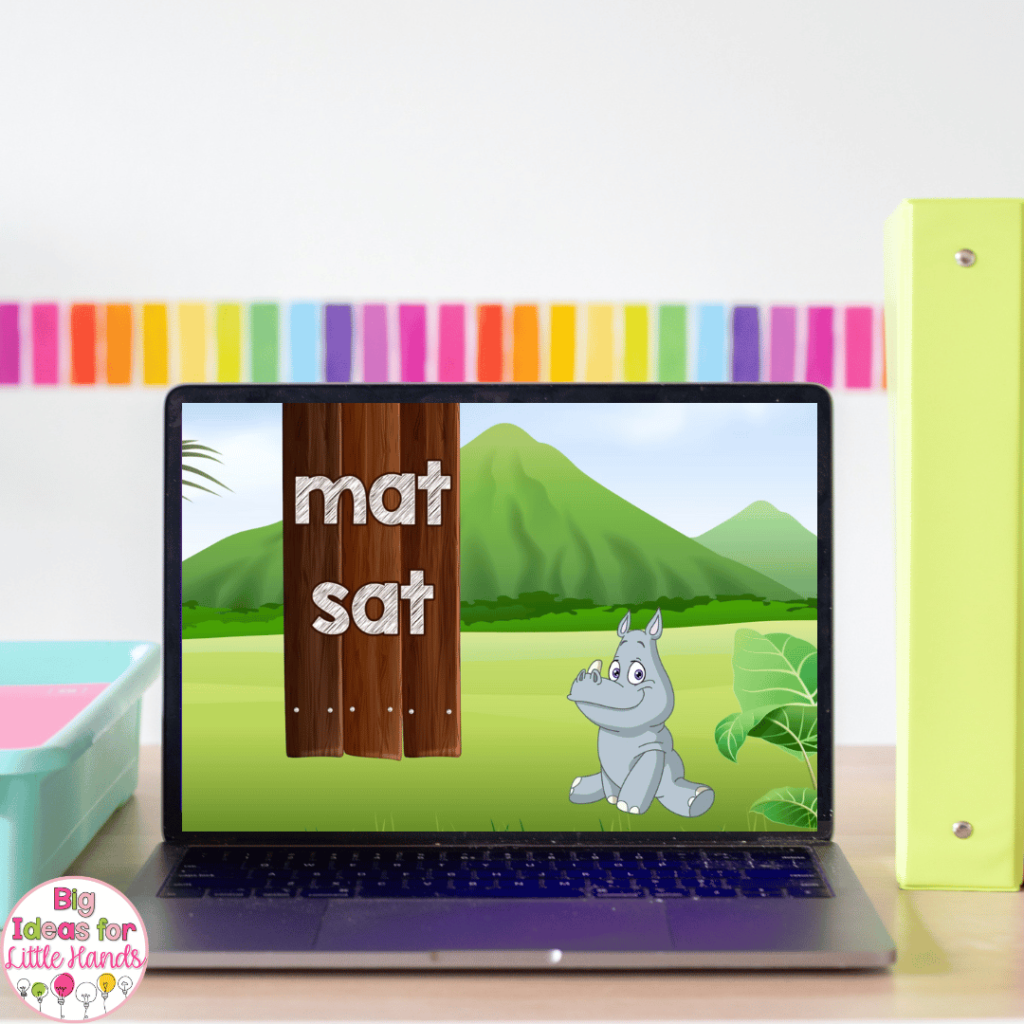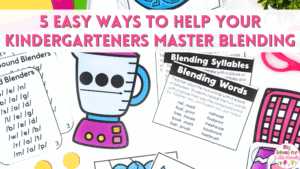Teaching young students to read is one of the most exciting things that primary teachers get to do. It’s pretty amazing to watch a student progress from letter identification, to letter sounds, to CVC words. Along the way, we work on other skills too – like rhyming. This is arguably one of the most important skills when it comes to learning how to read, which is exactly why we’re covering it in depth today!

Essential Phonemic Awareness Skills
Before we dive into rhyming, let’s do a quick overview of phonemic awareness. Phonemic awareness refers to the ability to identify, isolate, and manipulate sounds in spoken words. In phonics, these sounds are called phonemes. Phonemes can be represented by a single letter or a combination of letters that make one sound.
Many skills make up phonemic awareness and children must develop in each area to be strong, confident, fluent readers.
These skills are introduced in preschool and then taught in further depth in kindergarten and first grade. There are 8 essential skills to a strong phonemic awareness program. You can read all about each one in depth in this blog post, but today, we’re going to focus on rhyming!
Why Rhyming Matters
So why does this skill matter so much when it comes to learning to read? There are a few reasons that play into why rhyming is so very important.
1. Rhyming Helps Increase Vocabulary
As students work on rhyming activities, they are introduced to new words they might not have heard before. This is such an important part of becoming a strong reader! The more words students learn, the more they will be working towards fluency. Not to mention, learning new words is fun for students.
2. Rhyming Helps Students Recognize Patterns & Chunks

This might be the most important reason that rhyming is an essential phonemic awareness skill. To understand this, we have to think about fluency. When you read a book, do you read each letter individually? Of course not! That’s because you have developed fluency skills and can seamlessly blend letters and sounds together with ease. That’s what we’re shooting here for our students!
To get to this place of effortless fluency though, we must begin to recognize patterns in spelling, and common “chunks” of words that produce a specific sound. The more opportunities our brains get to identify these patterns and chunks, the more familiar they become. This is where the effort begins to fade and students will begin showing more fluency as they read. Rhyming is such an effective, and fun way to to achieve this.
3. Rhyming Makes Phonics Fun
Finally, we can’t forget that rhyming is just plain fun! As a kindergarten teacher, so much of my time and energy is spent on crafting literacy lessons that will light my students up with excitement. This is the goal in my room because I’ve come to know that the more fun my kids have, the more likely they are to retain what we’re focusing on. That’s another one of the reasons that you’ll want to make sure to include plenty of rhyming activities in your literacy lessons!
My Favorite Ways to Practice Rhyming in the Classroom
Now that you understand the importance of rhyming when it comes to learning how to read, let’s chat a little bit about how to incorporate rhyming into your lessons. There are so many fun ways to do this, but here are a few of my favorites!
Sing Songs & Use Fingerplays
All of those classic nursery rhymes, fingerplays, and songs are so useful when it comes to teaching students to listen for and identify rhyming sounds. This will be even more helpful to your students if you take the time to write out the words. I like to use words written on sentence strips with a pocket chart. I will place all the words in the chart and then use a pointer to point at each one as we sing. The kids love this and after we have sung a few times, I will usually choose a student to be the pointer.
By having the words on sentence strips I can easily take words out and have students figure out the missing word. We also move these into a center activity after we are done with it in our whole group setting.
But that’s not the only way we incorporate songs and chants. I love to project them on the front board too. YouTube is filled with fun rhyming songs and rhymes that you can use in your classroom. This one is one of our favorites! Use these types of videos as a warm-up before you break into groups for the day, or as a way to refocus when students seem less engaged. Just be sure to preview the videos all the way through first!
Use Books to Target Rhyming
Picture books are another fantastic way to target rhyming in the classroom. Try reading them aloud until your students know the words and then place them in your reading center. Kids will love pointing to the words as they read the text to their friends. There are so many fun ones out there but here are a few of my favorites:
- Chicka, Chicka, Boom, Boom by Bill Martin Jr. and John Archambault
- Giraffes Can’t Dance by Giles Andreae
- Rumble in the Jungle by Giles Andreae
- Room on the Broom by Julia Donaldson
- Frog on a Log? by Kes Gray and Jim Field
If your kids are anything like mine, these books are sure to get your classroom excited to recite rhymes together!
Play Games that Focus on Rhyming
I saved the best for last. . . games! This is my go-to method for practicing rhyming in the classroom. I love using a variety of games, especially in my small groups, to practice rhyming. They’re a fun way to get my students instantly engaged in what we’re working on. I mean, what’s better than kids learning without even knowing it, right?!
I have a ton of fun games inside my Rhyming Small Group Games Resource, but one of my favorites is called “I’m Thinking of a Word”. This guessing game is great for small groups but also works for the entire class as well. I tend to use it to help my class refocus after a transition or as a warm-up in our small groups.
I keep a stack of clue cards in a binder ring. To play, I will read one off and my kids try to guess the word. It’s a ton of fun and really draws them in. Some of the other rhyming games we play include:
- BINGO
- Thumbs Up/Thumbs Down
- Match & Cover
- Fluency Board Games
- Feed Me
- Fruit Salad
Inside my Rhyming Small Group Games Resource, you’ll find 16 different games that will strengthen your students’ ability to recognize and produce rhymes in a fun way! It makes it simple and easy to weave rhyming practice into your week.
Try These Games in Your Room!
Want to test out these small group games in your classroom? You can grab this free Match & Cover rhyming game right now! Just enter your email below.
No matter how you choose to incorporate rhyming practice in your lessons, I hope this post helped you understand why this skill is essential as children are learning to read! So get creative and sneak in rhyming practice wherever you can. It will benefit your students so much when it comes to fluency, plus they’ll have a ton of fun along the way!
Looking for More?
Rhyming is just one of the ways you can strengthen phonemic awareness. Check out these posts next for more ideas!
Save This Post
Make sure to pin this post on your favorite Pinterest board so you can keep track of these ideas to help students practice rhyming!









